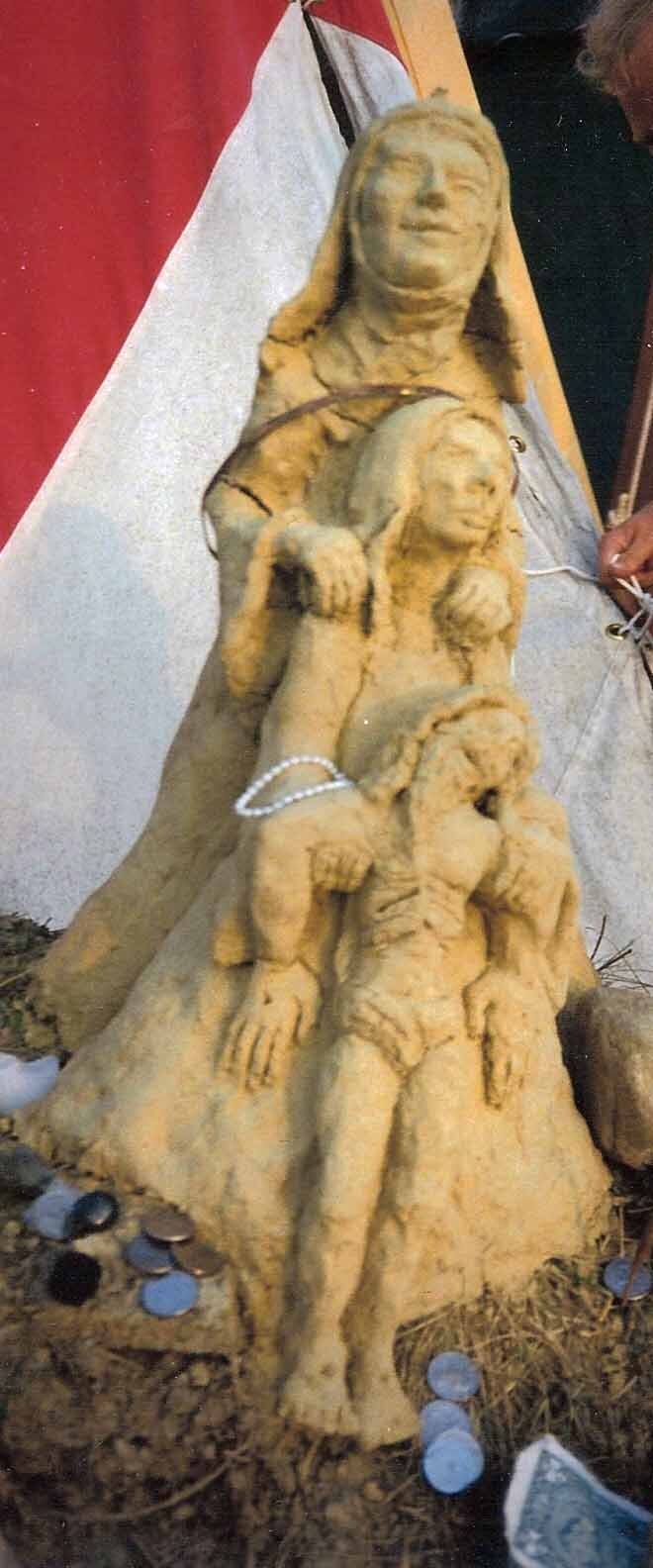Below is a new video interview about the meaning behind my work. I hope you enjoy it. Blessings, SybilLink for email subscribers.
On Icon Writing, Vessels and Sieves

Angel Gabriel by Vladislav Andrejev
During my college years, I had the great blessing of being able to study for a time at School of the Sacred Arts (SOSA) in NYC. It was an amazing place which gathered masters from many diverse spiritual traditions, teaching everything from Haiku, Tibetan butter sculpture, manuscript illumination, Russian Icon writing (painting), Tibetan Tonka painting, Indian dance, Chinese calligraphy and on and on. There were also lectures on mysticism and sacred traditions by scholars and spiritual leaders. Everything was geared to help you enter into and experience sacred mystical traditions, ground and guided by true masters. It was an amazing place which sadly closed years ago. It was here that I first met Lex Hixon, Karen Gorst (my co-author on Lapis & Gold) and studied Icon writing with Vladislav Andrejev.
Vladislav is an amazing man who radiates spirituality. I was in school at NYU and had to walk across Washington Square park to my Icon class in the old church that SOSA had taken over. I would often come upon Vladislav sitting on a bench deep in prayer in preparation for his class.Let me put it kindly, I was not a success at Icon writing. This class was probably my first conscious, overtly spiritual struggle and my first awareness of my ego's roll in defining my life.
To write an Icon, you have to set aside your ideas and submit to the form, following the master's instructions entirely. At that time, this was impossible for me. Directions and me didn't mix. I used to brag that I couldn't even follow the directions on a box of Kraft macaroni and cheese and it was true. Not because I was unable read the instructions or understand them, but because my need to control was so profound. I couldn't even follow the simplest instruction from someone, even written on a box, without arguing.
I wanted to write an Icon, but I want to "express myself" more. I was angry at being confined. I worked on an Angel Gabriel Icon and I was incensed that I could not alter the image at all to put my stamp on it. I was angry that I couldn't choose my own colors for the many layers that built Gabriel's face and clothing. It was absurd. I had big plans, but my plans interfered with my ability to write an Icon and striped me of the intimate knowledge and spiritual truths contained in that process.In Icon writing everything has form, order and meaning. Order and form are strictly prescribed. You must travel their path to get to meaning. You can intellectually understand the meaning, but it will have no impact on your spirit without surrendering completely into the process. Only in this way will mind and spirit become one in knowledge and can you grow spiritually.Vladislav's class made it very clear to me that I had a problem. Through him, for the first time, I began to be aware of how ego was dominating my life. Of course, nothing shifted then. It took me twenty years and 10 days in the cardiac ICU to learn to surrender. But the awareness first came from him, through the process of Icon writing. It is an art, like manuscript illumination, which has deep spiritual effects on the artist. It demands the artist be healed through its process because it's goals are so profound.Icons are meant to be windows to God. They seek to remove the veils between the Divine and humanity. They are filters that allow a more pure resonance of God's light to pour into the world. Theodore Roethke said:
Form is not regarded as a neat mould to be filled, but rather as a sieve to catch certain kinds of material.
This is a profound statement. We are not simply empty vessels to be filled with anything that comes along. We have a choice to filter and hold what is dear to us. Although we are vessels, we are active participants too.What I didn't understand yet in Vladislav's class is that our only work here is opening the door for Divine Light, that some more true expression of the Self can emerge from surrendering the self, and that we are filters and windows too, walking Icons. While written Icons capture a timeless moment of peace and surrender harnessed by the spiritual surrender of the artist, we move through time. Each moment becomes a choice- what will we filter, what will we surrender? What kind of window will we build, one filled with an an opaque and dirty glass or one luminous, bridging two worlds?Vladislav now teaches at Prosopon School of Iconology and has just released a set of instructional DVDs. Here is a short excerpt:To see more excerpts or order the DVD go to the Prosopon School of Iconology website and click "Process" on the left sidebar. I believe after 20 years of work I may finally be ready to be a beginning Icon writer. I am ordering this video.
On Clay
Clays are extraordinary, layered, crystal structures which have, built into them, what amounts almost to an innate tendency to evolve...Clay has plans.-Lyall Watson, from An Introduction to Clay Colloid Chemistry

I started as an artist at the age of 6 in clay. The altars (images below) I built from clay I dug directly out of the earth are some of the most satisfying pieces of my career. There is an innate connection between God and earth. Clay is a meeting place, a doorway to Heaven.I have been an avid gardener for years. I began to garden for the fragrance and color of flowers but now I garden for soil. It is easy to miss the Divine is the humble trappings of dirt. There is something about soil that is just afire with the light of God. It is the lowliest of things, we tread on it, ignore it, sweep it away, and yet it sustains us all. The soil pulses with life that we cannot or will not see. There is no more satisfying feeling than seeing what appears to be a barren, wormless plot of land transform into a teaming mecca of life.
Working with clay gives me the same satisfaction. Clay itself is very dense, like the material word itself. It takes effort to move it and to see in it the true reflection of the Divine. And yet it is responsive. There is something in clay that wants to grow and transform and which responds to that same impulse within the artist. Clay is a partner in the creative act, not a submissive servant.In the biblical story of the creation of man, God chooses to blow the breath of life into clay to create Adam. I have discussed this from the perspective of the gilder who must use breath, but the clay’s perspective is just as interesting.
That God chose clay to receive his direct kiss, should illuminate the central importance of Earth. By gardening or working with clay we engage the Earth. And if we empty ourselves and enter fully into the present moment something amazing happens. The artist becomes the physical vessel for Divine creative energy, holding it, that it may be translated into, fused with matter. The particular way in which an artist engages matter allows for greater concentrations of Macrocosmic energy to enter the world.But that is not all. All matter, to a greater or lesser degree has consciousness of its Source. Clay is like a sponge that actively seeks to draw in Divine fecund energy. It and Earth itself has its own active spirituality and deep connection to God.Contemporary theologian Thomas Berry argues this persuasively.
There is a spiritual capacity in carbon as there is a carbon component functioning in our highest spiritual experience. If some scientists consider that all this is merely a material process, then what they call matter, I call mind, soul, spirit, or consciousness. Possibly it is a question of terminology, since scientists too on occasion use terms that express awe and mystery. Most often, perhaps, they use the expression that some of the natural forms they encounter seem to be "telling them something".- Thomas Berry, The Great Work: Our Way into the Future, Page: 25
He also says:
“Gardening is an active participation in the deepest mysteries of the universe.”
Medieval theologian St. Thomas Aquinas wrote that
All things love God. All things are united according to friendship to each other and to God.
And mystics such as Teilhard de Chardin and Hildegard of Bingen see it everywhere:
Crimson gleams of Matter, gliding imperceptibly into thegold of Spirit, ultimately to become transformed into theincandescence of a universe that is person- and through all of this there blows, animating it and spreading over it a fragrant balm, a zephyr of union- and of the Feminine.The diaphany of the Divine at the heart of a glowing universe, as I have experienced it through contact with the earth- the divine radiating from depths of blazing matter.-Teilhard de Chardin
Hildegard of Bingen says:
God’s Word is in all creation, visible and invisible. The WORD is living, being, spirit, all verdant greening, all creativity. All creation is awakened, called, by the resounding melody, God’s invocation of the WORD. This WORD manifests in every creature. Now this is how the spirit is in the flesh--the WORD is indivisible from God.
Eden, 22k gold leaf and handmade paints on sheep skin parchment
So let us not discount the importance of our physicality and out Earth in a reckless attempt to find a higher spirituality. Spirit is not up there, it here in every atom and molecule, every glowing and vibrant speck of dust. Let us be present and embrace the bounty God has offered us by entering into the unceasing flow of Divine Creativity on Earth. By embracing the Earth we embrace the Divine.
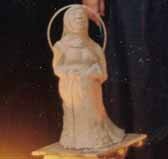
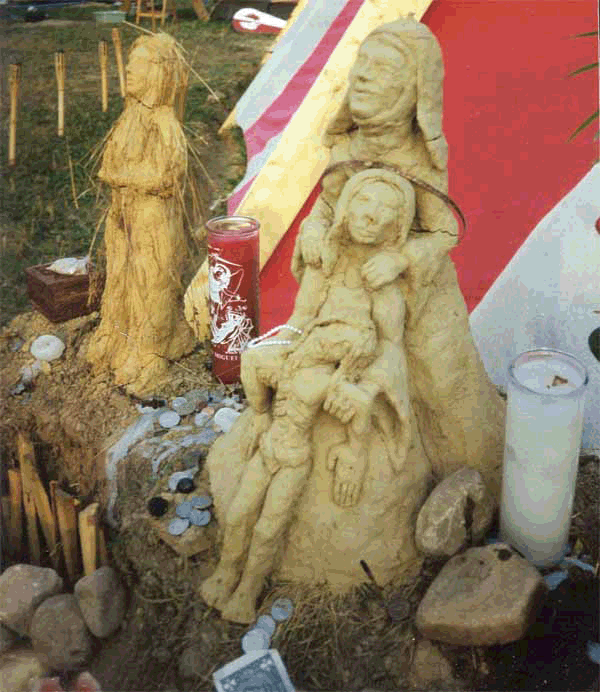
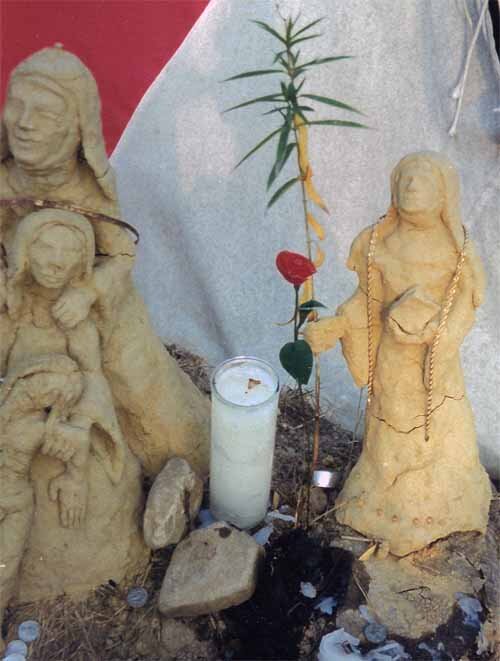
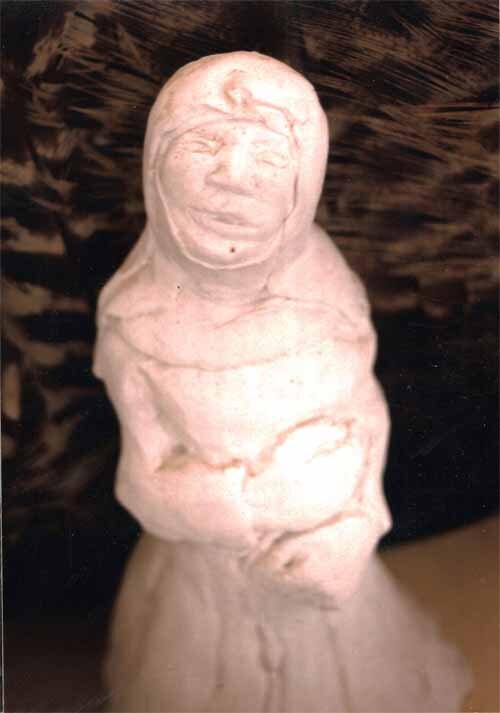
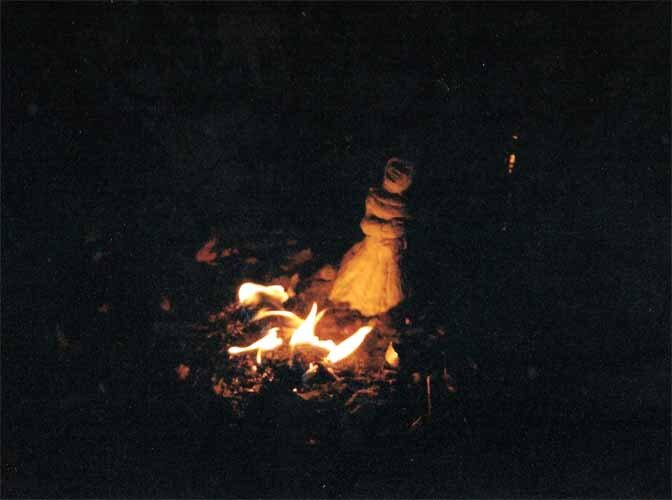
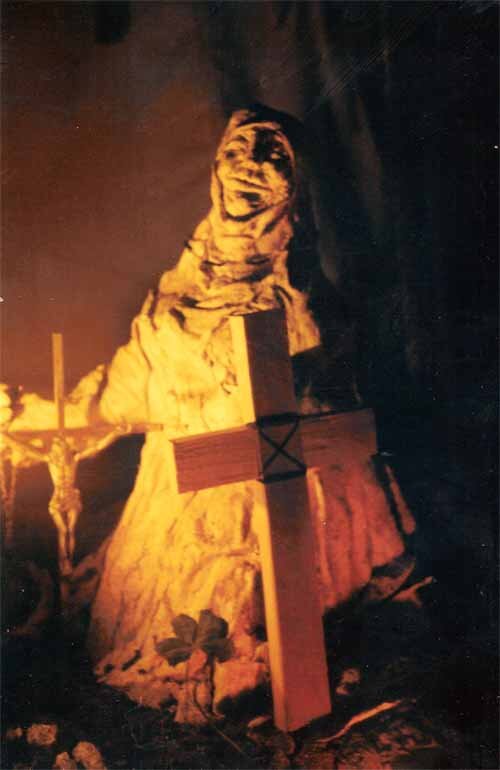
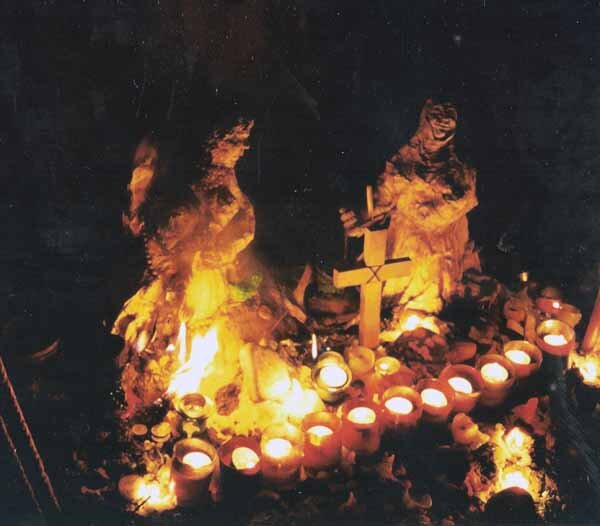
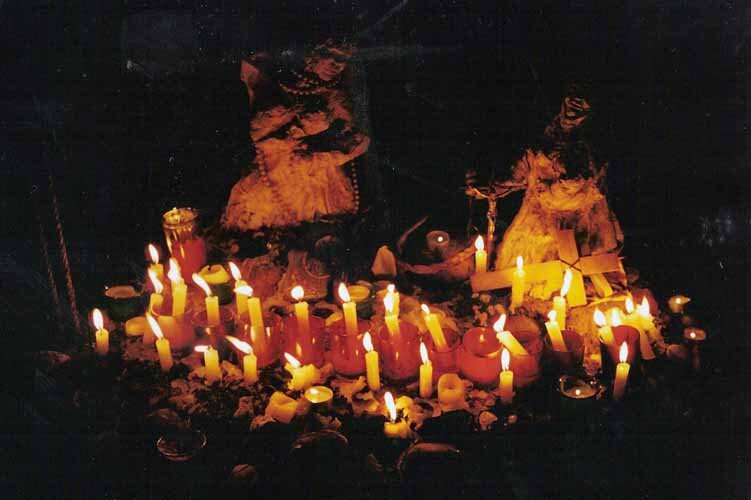
Lapis & Gold
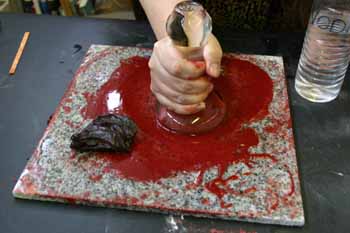

I just updated the website for my book Lapis & Gold: Unlocking the Secrets of Medieval Painters and Illuminators. It's an in depth look into medieval art technique and sacred and spiritual art practices. I hope it will help contemporary artists reclaim the power we’ve lost by relying on industrialized art supplies that pollute our environment and lack longevity. I also hope it will add to the dialogue about art as a spiritual practice. My writing partner, Karen Gorst, is a technical genius. There is so much in this book that has never been put to paper before. I’m really excited about it.I first became interested in illumination during college when I studied at the School of the Sacred Arts at the same time as I was immersed in studying medieval mystics at NYU. It seemed like the perfect art form to me, a marriage of the mystical and material. It is through illumination that I first began to understand the sacred and healing nature of making art. For many years, I strictly adhered to illumination technique:
The Binding of Isaac (Click image for larger view)
Now I just incorporate the techniques. I still make my own art supplies where I can but not always and I often work on paper instead of parchment. My work, however, is still true to the core values of the illumination technique: trust in process, trust in materials, and connection to the Divine. As Above, so below; the artist imitates the Divine Artist.I haven’t written much about my book here because I’ve been on an unplanned, life-enforced break. It had to be set it aside to help my husband close down his business in 2006 and then I had my heart episode/awakening and then our big move which caused my life to unravel into the chaos from which new things are built. I have, however, talked about many of the same themes of spirituality and have touched on technique in a few posts (see Finding the Sacred in Contemporary Art).I hope Lapis & Gold will appeal to a wide range of people. It has information for artists, art historians, spiritual seekers, conservators, medievalists and students of religion. Each chapter has technical information, ancient recipes tested and refined for contemporary use, history, and spirituality. (Click the links for chapter table of contents).
Supports: Paper and Parchment
Ink CalligraphyGilding
Pigments and Pigment Making
The Pigment Almanac (A reference guide to pigments)
PaintmakingProjects
A list of appendices
Here a sample of the types of information you will find in different chapters: the pigment chapter has detailed recipes, lightfastness & pigment interaction testing, and an in depth look at the alchemists who developed these recipes, their spiritual belief systems and how those believes manifest as you actually make each recipe; the calligraphy chapter has, among other things, directions for 3 writing styles, calligraphy as meditation, letter mysticism is the Christian, Judaic & Islamic traditions and the analysis of a medieval page to understand layout.So now finally the time is right to begin again on the journey that is my book. The writing in finished. Lapis & Gold has ripened* on the vine & is waiting for a hungry publisher to come and pluck it. Any advice, contacts, or help you could offer would be greatly appreciated!Thank you and bless you! Sybil* Upon rereading this, I was amused to find that I had unconsciously used the same metaphor as medieval alchemists who sometimes referred to the metals in their chemical reactions as ripening.
Healing the Earth: The Calling of the Spiritual Artist?



Yesterday I spoke at length about the importance of a spiritual artist merging the physical and spiritual worlds in the act of creation. All art springs from the fecund stream of Divine creativity. I also spoke of the sacred principle “as above, so below.” This principle basically means that everything is an echo of the Divine.In the figure of Jesus, God as revealed many things, not the least that Divinity and physicality can be merged. Whether you believe in Jesus or not, the symbol is a potent one. I am not suggesting that an artist can bring full Divinity into their work, but I am suggesting that Jesus is the macrocosm and art is the paler, yet important, microcosm, the echo for integrating the physical & spiritual.This is why the Earth becomes so important. As long as we fool ourselves into thinking that anything we do is separate from the Earth, was cannot bring God here. If artists see the ideas in their work as more important than their physical execution, God is lost. This is why, in my opinion conceptual art fails so radically.In our society we have forgotten that everything we use is a fruit of the Earth. Perhaps it is easy to grasp that eggs come from chickens, but what of paint in tubes, plastic boots, or children’s toys? Let’s stay with the artist. How many artists know the source of their own paint? Does anyone realize that watercolor paint sticks to the page because of tree sap or that true ultramarine blue come from crushed stones? (More on this here.)
An artist must fully accept and embrace physicality. This is almost an impossibly hard task because by doing so we become confronted with the brokenness of our planet. To bring God into physicality through the act of creation is an act of healing. It is no more or less significant than any act of healing. It is only our egos which put a value judgment on it: “It’s only a painting, what can it possibly matter?” Each piece of art is but a grain of healed sand, but sand can pile up as anyone who lives near the beach can tell you. An artist must be content to labor at thier Divinely given task. To be an agent of healing requires nothing less than complete abandonment of self will and trust in the Divine steam of creativity which flows through us. As artists, we are called to heal the Earth.My next post will be about how some mystics view of the earth and healing. In the meantime checkout these amazing posts on Earth & Spirituality:
Gartenfische (of course!)
Sound and Silence(This starts out about Halloween, but keep reading, it’s worth it)
Art & The Physical
Making art is a physical act with physical outcomes. The crux of the problem is how to join the physical and spiritual worlds. How do we bring the sacred into physical form and why?I am deeply influenced by the ideas of early alchemists who sought to purify matter. Most people have heard of how alchemists looked for the philosopher’s stone, an elixir, which would transform base impure metals such as lead into gold. They described their quest as perfecting or healing matter. Gold, the purest metal, a symbol of the Divine on earth was not the true goal of an alchemist. Alchemists believed in the sacred principle “as above, so below” as written in the Emerald Tablet. As the alchemist purified matter externally, they believed they were making corresponding internal changes to the own souls. Their true goal was spiritual perfection & union with God.The same principle is at work when an artist creates. Artwork manifests the spiritual changes occurring within the artist as they create. All creativity is ignited from the same flame, tapped from the same eternal well. By creating, artists contact & connect with their source and that fundamentally changes them. Why do you think so many artists turn to drink and flirt with madness? This connection with our source is awesome and can be overpowering and painful. Artists don’t need pain and suffering to create, but most of us are so closed off from our Divine source that when we access it, the pain of our separation crashes down on us in a crushing blow. It’s not the pain an artist needs to create, it’s the pain that comes with the act of creation.However, if an artist or mystic continues to seek God eventually they become tempered like a sword in the fire and can bear more closeness with less pain. When the artist learns to allow the fecund stream of Divine creativity to flow through them with out expectation or control, the artwork which is created resonates with God. This artwork becomes a pivoting point from this world to the next. But the goal is not to escape the physical and return to God, it is to join the two worlds as one. Art can provide a powerful experience of the Divine in a way few other things can.Sister Wendy has a really interesting passage in her book The Mystical Now: Art and the Sacred (Thanks John for pointing it out to me!):
GK Chesterton, mourning our state as fallen creatures, ego-lovers…explained: ”We have forgotten who we and what we are.” And art, he said, ”makes us remember that we have forgotten.” This is painful. It is also our best means apart from direct contact with God, of rediscovering that interior integrity. All great art, being spiritual, both grieves over and celebrates “what we are.” It needs no religious iconography for this…(p. 9)
She goes on to say that this is why “so many people unconsciously fear and resist art.” It is not the fear of art, it is the fear of God.I think it is clear from what I have said, that artists have a responsibility for the physical nature of what they create. Elsewhere, I’ve discussed the artist’s responsibility to the Light, to choose to be a vessel for light and good in this world. But this is slightly different. Artists also have a responsibility to the material world. As the alchemists did with metals, the artist purifies matter in the act of creation. Our responsibility is nothing less than to be active participants in healing the earth. My next post will clarify this in further.
Icon Writing & Contemporary Artists
Angel Gabriel Icon- My first attempt at an icon in process
Iconographers say that icons are written, not painted. They are believed to embody the Word, God, in physical form. Icons act as physical windows into Heaven and icon writing is a direct experience of the Divine.In life, we have the illusion that we are in control, that we pick our jobs, our mates, etc. It’s not true, but it feels that way (See Gartenfische for more on this). In the process of icon writing, that illusion is stripped away. Every form, every color, every technique is strictly prescribed. This is very hard on the ego believe me! See my attempt at an icon above. I studied under Vladislav Vladislav Andrejev at the School of the Sacred Art, but my ego was too strong at that time to enter fully into the process. In forcing the ego to submit, the artist is healed and brought closer to God. It is this healing moment which is captured in the icon. This moment resonates purely with Source and transforms a block of wood, egg yolk and pigment into a doorway to the Divine.Before writing an icon, it is customary to pray. Here are some excerpts from a traditional prayer. It is extremely interesting how much of this prayer has to do with healing and cleansing the artist.
Glory to Thee O God, Glory to Thee.
O Heavenly King, Comforter, Spirit of Truth, Who art everywhere present and fillest all things, Treasury of Blessings and Giver of Life, come and abide in us, and cleanse us from every impurity, and save our souls, O Good One. …Master, pardon our iniquities.Holy One, visit and heal our infirmities, for Thy Name's sake.Lord have mercy, Lord have mercy, Lord have mercy.…Enlighten and direct our souls, our hearts, and our spirits. Guide the hands of your unworthy servant so that we may worthily and perfectly portray Your Icon, that of Your Holy Mother, and of all the saints, for the glory, joy, and adornment of Your Holy Church.Forgive our sins and the sins of those who will venerate these icons, and who, standing devoutly before them, give homage to those they represent. Protect them from all evil and instruct them with good counsel.….Amen
For the whole prayer click here. This is very traditional religious language, but we can look deeply and see a universal message.Let’s go back to intention. The icon writer intends to meet God. Such a lofty goal necessitates transformation. If, as in much contemporary art, the artist’s goal is to shock, or argue a point, self-aggrandize, then really why bother. We all get that every second of everyday anyway!Each of us has this one life, this one moment to shine and add luminosity to the world. Why would we choose anything other than fearless, unrelenting opening to God?
--------------------------------
I have chosen different spiritual path from icon writing in my art. Icon writing requires the will to will God’s will. This a beautiful and rich spiritual path, amazing. But my aim is different. I seek to tread what is called the via negativa. I wish to release my will completely, not even to will God’s will. I wish to be an empty vessel, a womb, open to be filled by the Divine. Every thing, thought, and idea I can release makes more space for the Divine creative flow to fill and perhaps birth forth as something completely new.


